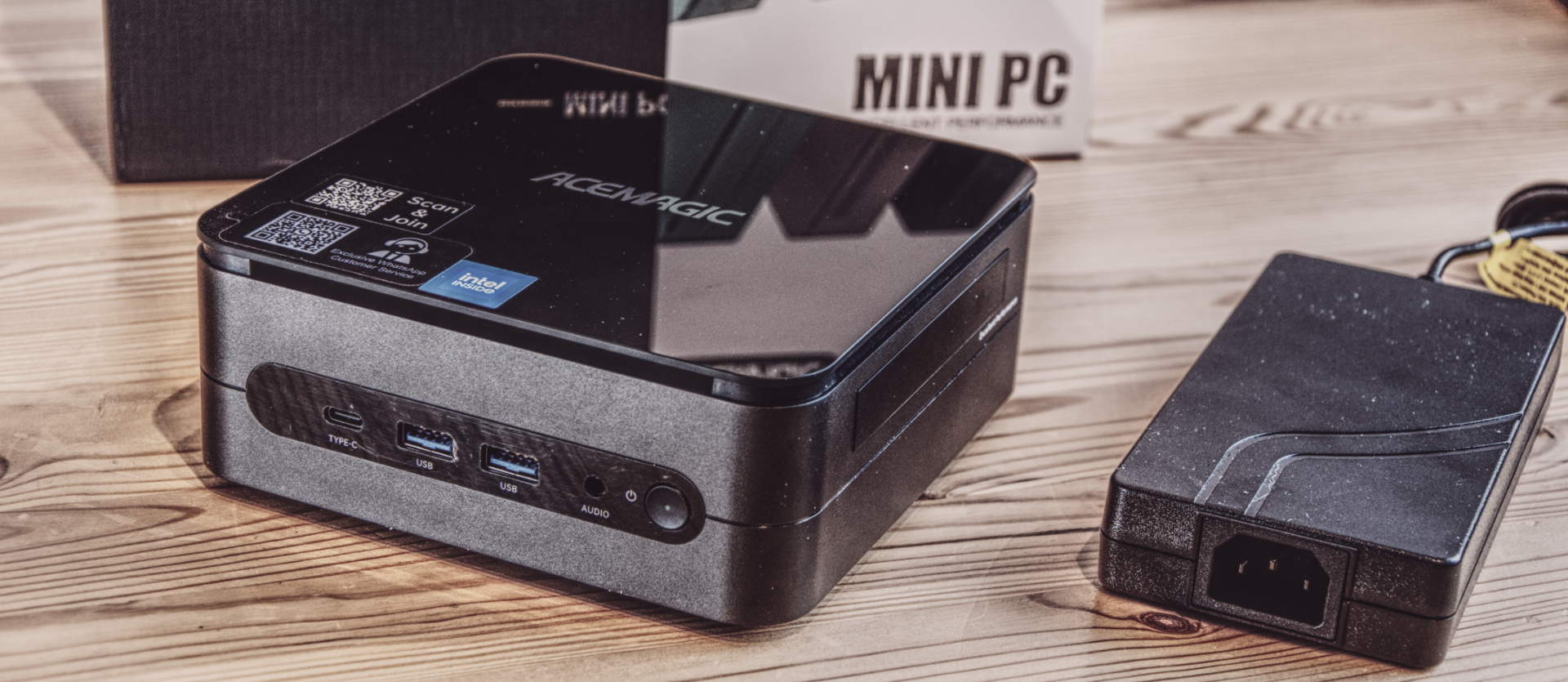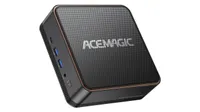TechRadar Verdict
Had Acemagic not recently released the F2A, powered by a Core Ultra processor, then the Core i9 in this machine might seem more exciting. For the money, it fails to deliver the performance purchasers might expect, and there are better options.
Pros
- +
Lots of cores and threads
- +
Easy internal access
Cons
- -
Mostly plastic construction
- -
Only one M.2 slot
- -
No Thunderbolt or USB 4.0
- -
Expensive
Why you can trust TechRadar
30-second review
Having recently experienced what Acemagic can achieve using the new Intel Core Ultra 5 125H in its F2A Mini PC, the F1A is a retrograde step on the processor front.
While the Intel Core i9-12900H CPU has fourteen cores and twenty threads, it uses the previous Iris Xe GPU and DDR4 memory, not the ARC GPU and DDR5.
Considering that the Core Ultra 5 in the F2A is at the bottom of that series, and the i9 is very near the top of its generation, the i9 struggles to deliver equivalent performance levels.
To compensate for these limitations, Acemagic placed the F1A in a larger case, which provides plenty of room for an elaborate cooling solution. But, the extra space isn't used as expected, as it only has a single pre-installed M.2 2280 NVMe slot. Many machines, even those in smaller enclosures, come with two, and a few even three.
We've reviewed all the best mini PCs and for us, where this machine is underwhelming is the use of the available PCIe lanes, considering that the Intel Core i9-12900H CPU has twenty-eight of these.
On the front are two USB 3.2 Gen 2 Type-A and one USB 3.2 Gen 1 Type-C port. On the rear are two more USB 3.2 Gen 2, but that still only adds up to a maximum of a couple of PCIe Lanes. The single M.2 slot is a PCIe 4.0 Gen 4, leaving at least 20 PCIe lanes unused, even if a whole PCIe lane is allocated to the LAN port.
Overall, this isn't a great example of exploiting a chip like the Intel Core i9-12900H CPU, and the asking price is way too high to represent good value for money.
Sign up to the TechRadar Pro newsletter to get all the top news, opinion, features and guidance your business needs to succeed!
Acemagic F1A: Price and availability
- How much does it cost? From $700
- When is it out? Available soon
- Where can you get it? Directly from Acemagic and Amazon
Unusually for a Mini PC, Acemagic offers only a single SKU of the F1A, though it is available in three colours.
Sakura Pink appears to be the 2024 twist on Rose Gold, the Emerald Green has a mint chocolate wrapper vibe, and thankfully, we received the third option of Graphite Black.
At the time of writing, direct from Acemagic, these machines aren't the same colour, with the Black costing $769, the Green another $10, and the Pink is bizarrely $799.
The one hardware specification is for 32GB of RAM and 1TB of storage, but the packaging hints that Acemagic might sell machines with less RAM and alternative storage should the demand exist.
As part of a Memorial Day promotion, a 33% off promotional code is currently available, significantly reducing the cost. However, we have no idea how long that will last.
Alternatively, all three colours can be bought from Amazon.com for $699, and a further $100 discount voucher is available.
If we assume that the hardware will eventually return to MSRP, this doesn't look like a great deal, especially since some brands are selling Core Ultra machines for less than that figure.
But below $600, this might be a much better deal for those who don't intend to upgrade the machine further down the line.
- Value: 3 / 5
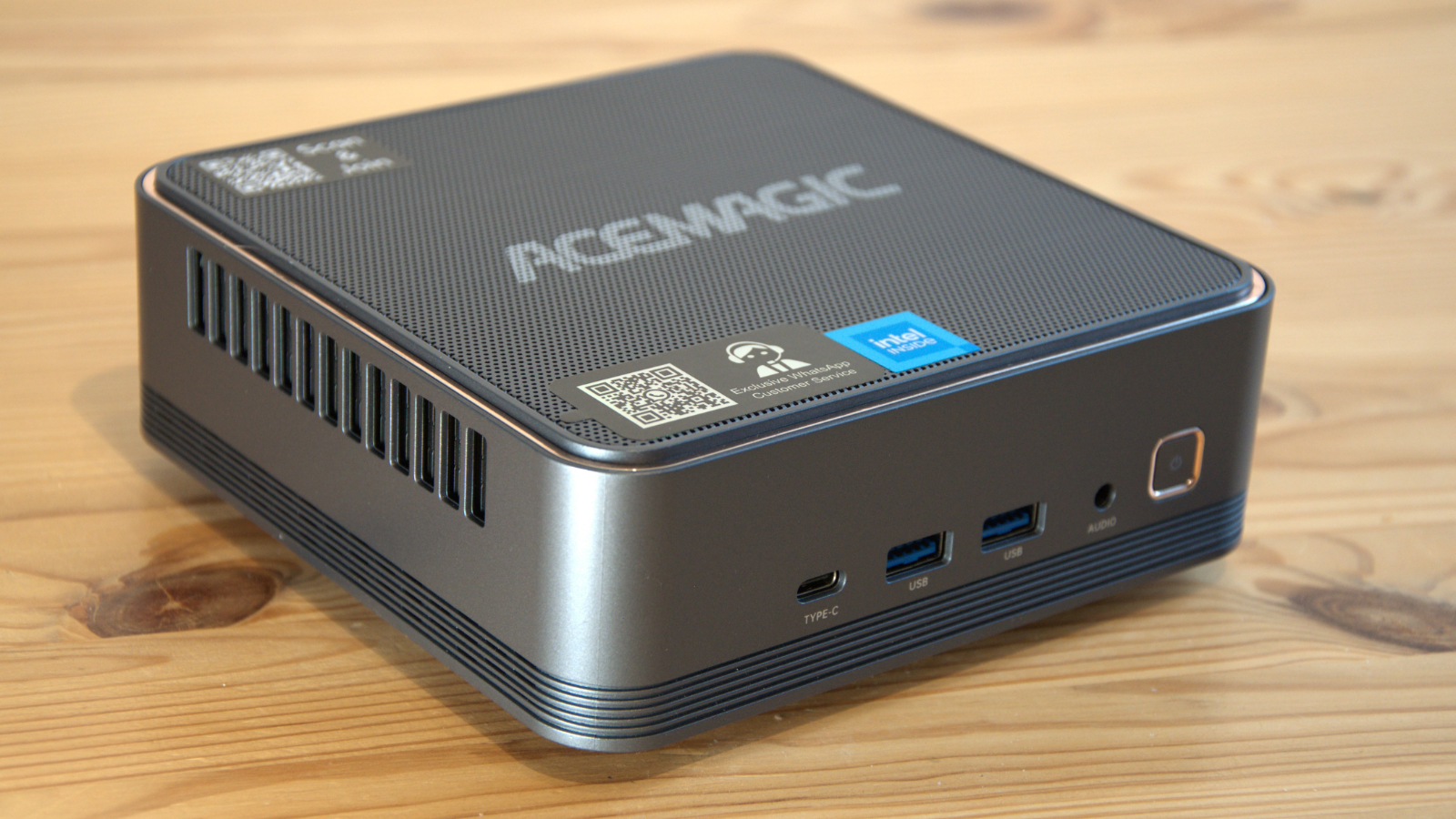
Acemagic F1A: Specs
| Item | Spec |
|---|---|
| CPU: | Intel Core i9-12900H (14 cores, 20 Threads) |
| GPU: | Intel Iris Xe (96EU) |
| RAM: | 32GB DDR4-3200 (16GB x 2) expandable to 64GB) |
| Storage: | 1TB M.2 2280 PCIe Gen 4 |
| Expansion: | N/A |
| Ports: | 4x USB 3.2 Gen 2 Type-A, 1x USB 3.2 Gen 1 Type-C, 1x HDMI 2.0b, 1x universal audio jack |
| Networking: | 1x 2.5GbE LAN, WiFi 6, Bluetooth 5.2 |
| OS: | Windows 11 Pro (pre-installed) |
| Base Power: | 45W |
| PSU: | 19V 6.3A 119.7W |
| Dimensions: | 148 x 148 x 56 (mm) |
Acemagic F1A: Design
- Metal skinned plastic
- Easy internal access
- A disappointing port selection
To give many laptops a more luxurious feel, the use of a plastic shell bonded to thin aluminium skin has become a common feature. This technique gives mobile machines the impression of metallic construction without the associated weight penalties.
The F1A is one of the first mini-PCs we've seen with this type of construction, and it provides a nice tactile experience while leaving the hardware remarkably light.
It's not as robust as a solid aluminium chassis of a millimetre or more thick, and large parts of the F1A are entirely plastic. Still, it leaves a positive impression on the customer.
One thing that Acemagic are generally good at delivering is a machine where internal access is straightforward.
On this machine, the four feet unscrew are only finger-tight, and you are inside the portion of the system where you can access the internal memory and storage. Acemagic also used an inline connector for the fan connected to the underside, allowing it to be easily detached and reconnected.
That's good, and you can easily access the SoDIMM DDR4 memory modules and the M.2 Slot. However, the marketing materials on the Acemagic website declare that there are two M.2 slots and even include a photograph of them.
This is massively misleading since the F1A only has a single slot, or at least in the hardware sent to reviewers.
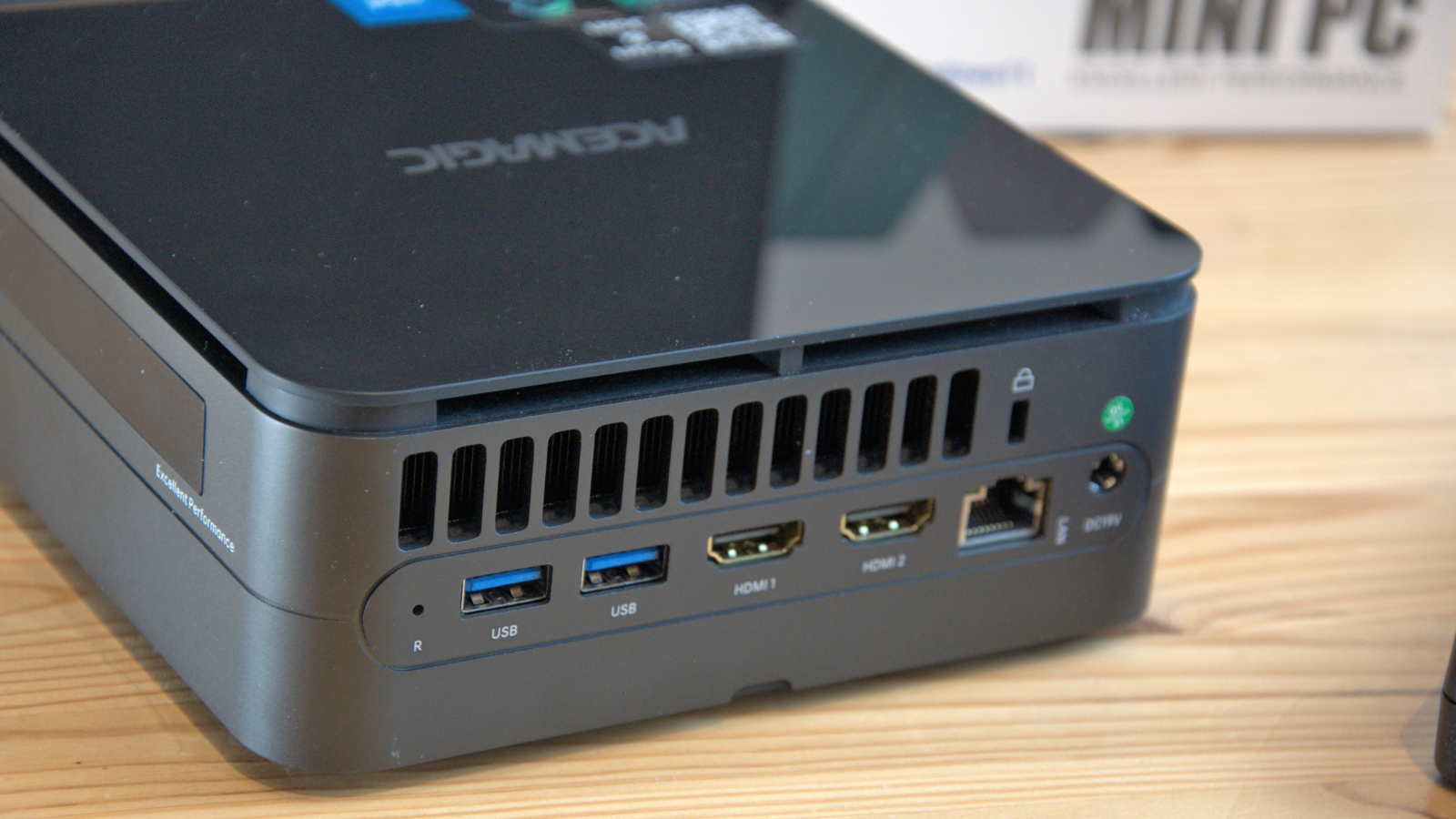
Maybe at some point in the design cycle, it may have had two slots, but based on the hardware we've tested, it has only one, and that's an awkward omission.
Having only one storage slot makes upgrading the module in that slot more challenging, as you will require an M.2 USB caddy.
As we'll discuss in the features, this hardware has a bountiful amount of PCIe lanes, but most go entirely unused.
While there are four USB 3.2 Gen 2 ports, the single USB-C port is only Gen 1 spec, and there are no USB 4.0 or Thunderbolt ports on it. There also isn't an SD card slot, and only one 2.5GbE LAN port is included.
Therefore, the selling point of this machine is the power of the processor, but in other respects, it doesn't provide any more I/O than a budget NUC.
- Design: 3 / 5
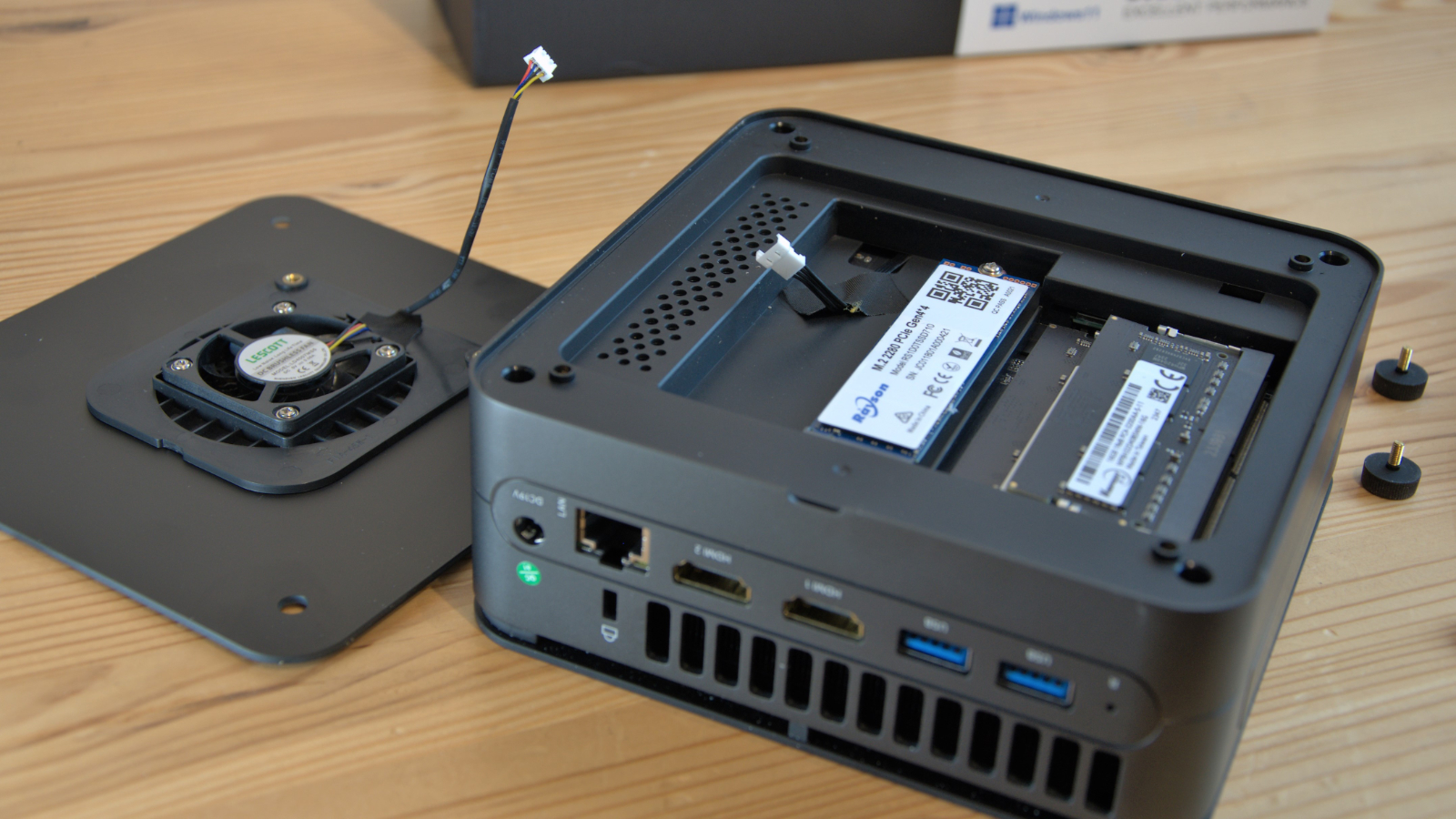
Acemagic F1A: Features
- Intel Core i9-12900H
- Unused bandwidth
- Iris Xe has dated
The headline act in the F1A is the Intel Core i9-12900H, an Alder Lake-H design that first appeared in early 2022. It's a 12th-generation design, which makes it two rungs behind the latest Core Ultra options. With the exception of the unlocked 12900HK, this is the top-level CPU from this series with a base clock of 2.5GHz and a Turbo boost of up to 5GHz.
The cores on this chip are six P-cores and eight E-cores, with the P-cores having hyperthreading to deliver twenty threads from fourteen cores.
The two things holding back this design were the amount of Smart cache, 24MB, and the number of performance cores. Intel released the 12950HX about five months after this chip with 30MB of Smart cache and eight P-Cores for even more processing power. However, the trade-off from the 12900H was its Irix Xe with 96 Execution Units, whereas the 12950HX and 12900HX only had a UHD Graphics GPU with 32 EUs.
On paper, this is a powerful platform, and with 28 PCIe lanes, there is plenty of bandwidth potential to offer, enabling the capacity to connect bandwidth-heavy functionality like 10GbE LAN ports and Thunderbolt.
Having all those lanes is ideal. But in this design, these mostly go unused. Acemagic didn't include a second M.2 NVMe slot, and it has no USB 4.0 or Thunderbolt ports.
Given how many machine designs we've covered were undermined by the lack of PCIe lanes that the i9-12900H has inherently, it's most disappointing that they're not made more of here.
It also must be mentioned that the Iris Xe, while fine when this chip was launched, doesn't compare well with the Radeon 780 on the latest AMD Ryzen chips or the ARC Graphics GPU that Intel is now using.
A factor in why it doesn't compete more is that in this era of Intel mobile chips, they used DDR4 memory, not DDR5, which is currently the memory model of choice. With DDR5, memory fetches from the CPU are speed-enhanced by being dual-channel in a single stick. With an integrated GPU that uses shared main memory, DDR5 can also speed up GPU operations.
The DDR4 used here impacts the CPU and GPU with less bandwidth and a lower level of performance overall.
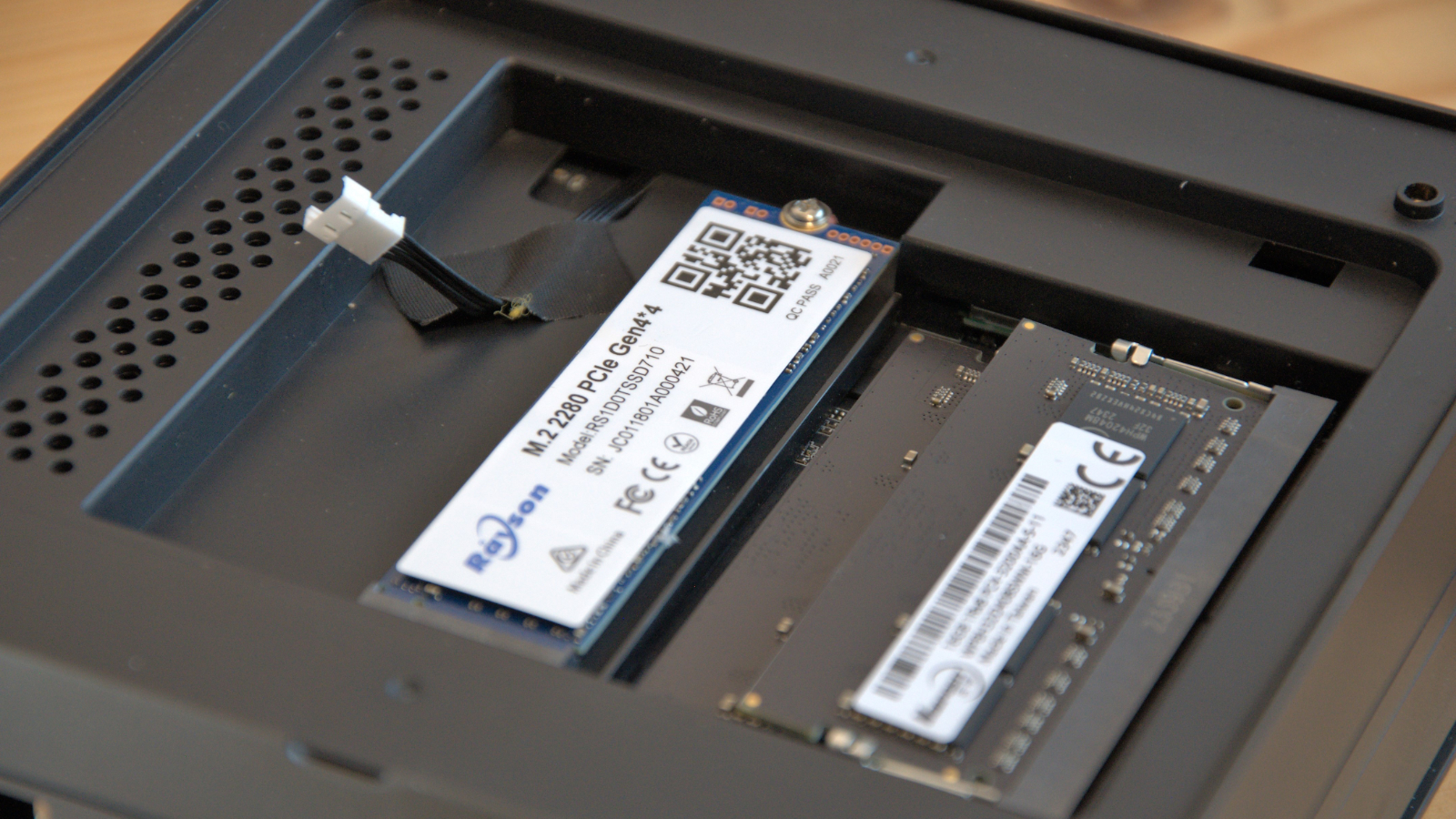
- Features: 3 / 5
Acemagic F1A: Performance
| Mini PC | Header Cell - Column 1 | Acemagic F1A | Acemagic F2A | GMKtec K8 |
|---|---|---|---|---|
| CPU | Row 0 - Cell 1 | Intel Core i9-12900H | Intel Core Ultra 5 125H | AMD Ryzen 7 8845HS |
| RAM | Row 1 - Cell 1 | 32GB DDR4 (2x16GB) | 32GB DDR5 (2x16GB) | 32GB DDR5 (2x16GB) |
| Storage | Row 2 - Cell 1 | 1TB Rayson RS1D0TSSD710 | 1TB KINGSTON OM8SEP41024Q-A0 | 1TB NVMe |
| Graphics | Row 3 - Cell 1 | Iris Xe Graphics (EU96) | Intel Arc Graphics | Radeon 780M |
| 3DMark | WildLife | 12610 | 18072 | 16149 |
| Row 5 - Cell 0 | FireStrike | 4944 | 6856 | 7664 |
| Row 6 - Cell 0 | TimeSpy | 1759 | 3424 | 3102 |
| CineBench23 | Single | 1830 | 1651 | 1764 |
| Row 8 - Cell 0 | Multi | 12494 | 14474 | 15691 |
| Row 9 - Cell 0 | Ratio | 6.83 | 8.77 | 8.9 |
| GeekBench | Single | 1768 | 1655 | 1957 |
| Row 11 - Cell 0 | Multi | 9657 | 10442 | 11864 |
| Row 12 - Cell 0 | OpenCL | 17365 | 27553 | 34563 |
| Row 13 - Cell 0 | Vulkan | 17157 | 23474 | 30270 |
| CrystalDisk | Read MB/s | 4786 | 3792 | 5105 |
| Row 15 - Cell 0 | Write MB/s | 4505 | 1627 | 4390 |
| PCMark 10 | Office | 6031 | 6771 | 7396 |
| WEI | Row 17 - Cell 1 | 8.3 | 8.1 | 8.2 |
Our choices for comparison in the testing were the Acemagic F2A, with its Ultra Core 5 CPU, and the GMKtec K8 and its AMD Ryzen 7 8845HS.
The one spot of sun for the F1A to bask in is the single-core processing power of the
Core i9-12900H, which is better in CineBench and GeekBench than either of the other options.
However, none of the multi-core results are as good, and things get ugly once the graphics scores start to show how badly the Iris Xe with DDR4 compares to the Radeon 780M when used with DDR5 or the ARC Graphics GPU with DDR5.
What elevates WEI (Windows Experience Index) and PCMark 10 results is that Acemagic used a decent NVMe drive that was significantly better than the one it put in the F2A.
What's most sobering about these results is that the GMKtec K8 is a much cheaper machine, at around $650 for the 32GB+1TB spec.
It also needs to be mentioned that the K8 has dual 2.5GbE LAN ports, dual M.2 2280 slots and USB 4.0 ports, making it a much more flexible solution.
Overall, unless you are looking for single-thread performance, this platform has been outclassed for some time.
- Performance: 3.5 / 5

Acemagic F1A: Verdict

Based on what deal Intel might have offered on these processors, Acemagic undoubtedly thought that reworking a previous i9 design might shift lots of these.
However, in the PC industry, the two and a half years since this chip was released have seen significant developments, and this platform suffers in comparison to more modern chips because it doesn't use DDR5 and has an older integrated GPU.
Features that might have made the difference would have been a full I/O suite, but Acemagic didn't add USB 4.0, Thunderbolt, or even a second M.2 slot.
If you have a single-threaded use case and want a Core i9, this machine is an option, but it lacks the potential to be easily repurposed for other tasks.
The F2A is a much better machine from Acemagic, but the cost of the F2A and F1A is too high to be seriously considered in such an aggressive market segment.
Should I buy a Acemagic F1A?
| Value | Expensive for tech that’s 30 months old | 3/5 |
| Design | Easy access, but not much inside. | 3/5 |
| Features | Plenty of USB 3.2 Gen 2, but no Thunderbolt, and only one M.2 slot. | 3/5 |
| Performance | Fast at single tasks, but overtaken on multi-core tests and GPU performance | 3.5/5 |
| Overalls | Expensive and lacks USB 4.0 or Thunderbolt, and it is not worth what Acemagic thinks. | 3.5/5 |
Buy it if...
You have a single-thread problem
This CPU is wonderful for single-thread performance if nothing else. It's also quiet, and the thermal management is excellent. This might work well for an embedded job with limited ventilation.
Don't buy it if...
You need Thunderbolt or USB 4.0
For whatever reason, Acemagic left Thunderbolt and USB 4.0 off this machine, leaving it with only USB 3.2 Gen 2.
You want better value
With new processors from AMD on the horizon, and cheaper Core Ultra from Intel coming, buying old Intel tech at this price doesn't deliver good value.
Also consider
Acemagic F2A
Using the latest Ultra 5 class processor from Intel with the ARC-integrated GPU, this is another powerhouse solution, from the same stable.
The downsides to this option are that it is more expensive and it also doesn't have USB 4.0 or Thunderbolt. But it's another powerful small system to consider.
Check out our Acemagic F2A hands on
GMKtec NucBox K8
With eight cores and sixteen threads to unleash, this is easily one of the most powerful NUC systems available, and it comes with the Radeon 780M GPU for some decent graphics.
In addition to its enviable power profile, this is also a flexible machine with dual M.2 Gen 4 NVMe slots and dual 2.5GbE LAN ports. Unfortunately, it also sports a USB 4.0 port, but it does not have Thunderbolt.
Check out our GMKtec NucBox K8 review
Mark is an expert on 3D printers, drones and phones. He also covers storage, including SSDs, NAS drives and portable hard drives. He started writing in 1986 and has contributed to MicroMart, PC Format, 3D World, among others.
